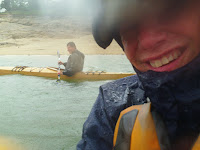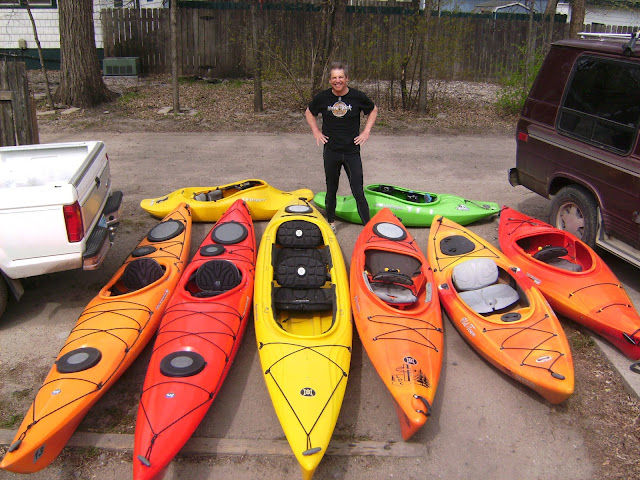Cuz, I'm canoeing with Daddy, And it's just like magic. When he hands me my paddle, get a great big smile on my face. ---Jerry Vandiver
On some lake, somewhere, this weekend there will occur the long-established and age-old tradition of a father taking his son or daughter canoeing for the first time. I've seen it many times at Sly Park Paddle Rentals, where I have run the boathouse during the past several seasons.
Young children will come bouncing down the dock with the excitement and wonder of Christmas Day. They will be followed by a just as excited adventuresome Dad hoping to relive some of his memories from his days at summer camp. While Dad fills out the rental forms, the kids are exploring by looking over the dock at the fish swimming by below. Not before long, the family wiggle into their PFDs and board the canoe. One takes the bow while the other sits on a pad in the hull canoe. Paddles are handed out. They're ready.
Dad, I'm sure, is holding his breath as he pushes off from the dock and as smiles break out among the crew. The lake is calm. The only disturbing it is the bow cutting way through the water.
"Bye," they call out as they paddle away on their new adventure, "We'll see you later."
"Maybe my most indelible canoe memory," the current Prime Minister of Canada, Justin Trudeau recalled in an essay in Cottage Life about canoeing with his father the long-serving Prime Minister of Canada (1968–1979, 1980–1984) and celebrated canoeist, "Was one of the rites of passage for the Trudeau boys: When we hit five or six years old, our dad would put us into the canoe and we’d shoot the rapids on the stream that went down into Meech Lake. With much trepidation, we’d sit in the front and go down the drop. I look back on it now and laugh because my father was sterning, and there was nothing I could do from the bow to aim it right—but it was very, very important for us to do it. To get into the bow of a canoe with my father for the first time, to be the bowman for the first time, and to go down this big, scary rapid."
 |
| Via Twitter |
He routinely shares Twitter pictures of him and his family canoeing and says every year he still tries to get out for at least a few days or so in the summer and take a canoe trip. And to think of it all started with a canoe trip with his dad.
There are so many benefits to canoeing with your kids and families. From spending time outdoors together to learning a skill, canoeing with your children is a great way to get active on the water at any age. Canoeing is something the whole family will enjoy in the many years to come.
Tips For A Successful Canoe Trip With Kids
PFDs, PFDs, PFDs. Everyone should be wearing one. In California, every kid under the age of 13 must be wearing while on the boat. And to be a great example of safety for them, you should have one on as well. How else can I expect my kids to follow that rule if I do not?
Don't plan for a long trip. The first few trips are all about fun. Remember your first trip in a canoe and how it set the stage for your love of the outdoors. Those future trips that the joy will come. But right now, you're helping your kids build a foundation of life on the water and planting a seed of recreating outside. A short trip around the lake is a great way to get your kids paddling. In your float plan include a good lunch/ swimming spot. Breaking up the paddle and tiring the kids out with some good ole fashioned playtime is essential.
Keep calm and paddle on. Most of the time, your little tykes will enjoy sitting up front in the bow, between your legs. Give some instruction on not s to stand up in the canoe and how to paddle but keep it simple. We're having fun. If you crash into the bank. It's OK. Laugh about. Paddling skills will get better throughout the day. And remember, no yelling or scolding.
Plan on getting wet and dirty. It’s scientifically proven fact canoes attract murky water to the bottom of the canoe. What is more fun than mud and water? So wear water shoes and clothes that will be OK to get a bit soggy. That might include your backpack too.
Pack lots of snacks and water bottles. Who doesn't love snacks? But please keep those kids hydrated too.
Sunscreen and hats. It's pretty simple to protect the kids from getting sunburn.
And don't forget the camera. This a one of those memories you might just want to remember for a while.
You don't have to wait for Father's Day to take your kids canoeing. Traditionally summertime into fall is the best time to go.
If you want to go on a canoe or kayak trip at Sly Park contact:
Current Adventures Kayak School and Trips
PHONE: 530-333-9115 or Toll-Free: 888-452-9254
FAX: 530-333-1291
USPS: Current Adventures, P.O. Box 828, Lotus, CA 95651
info@currentadventures.com
owner Dan Crandall dan@kayaking.com










































